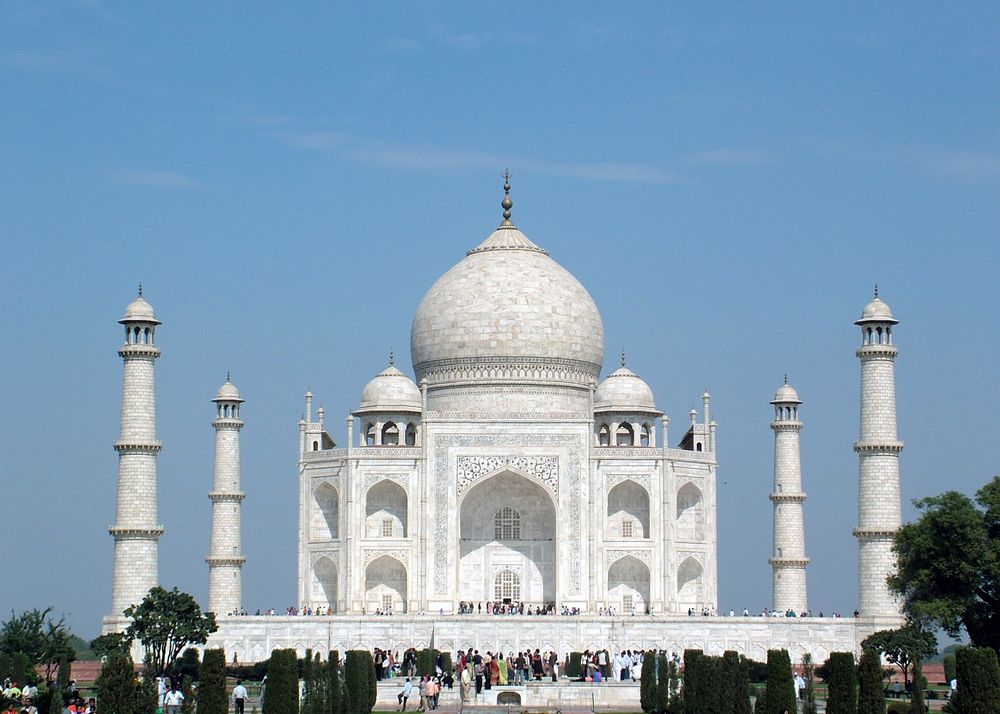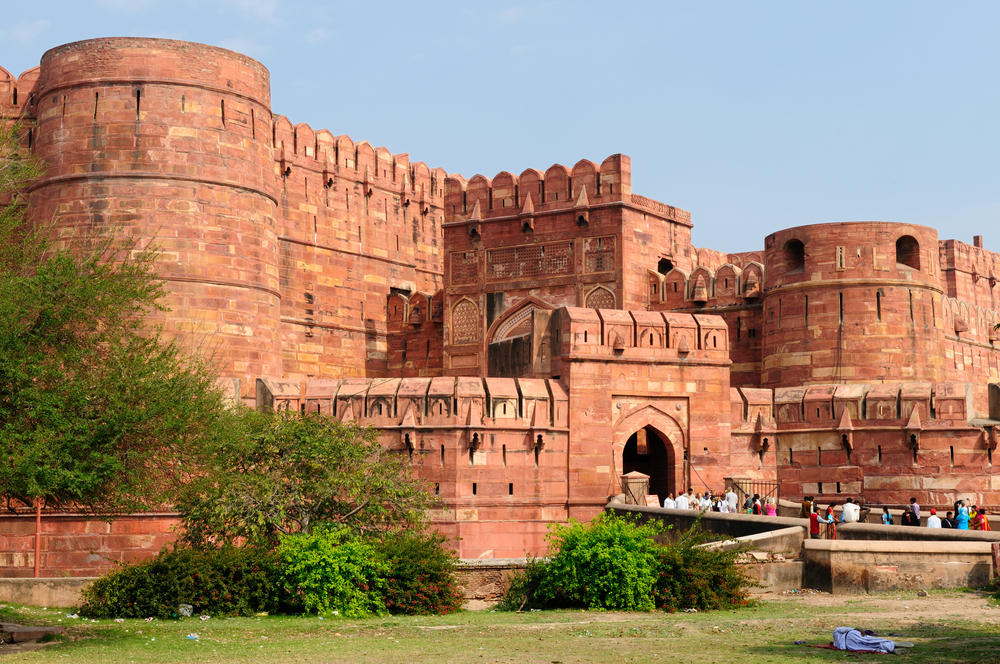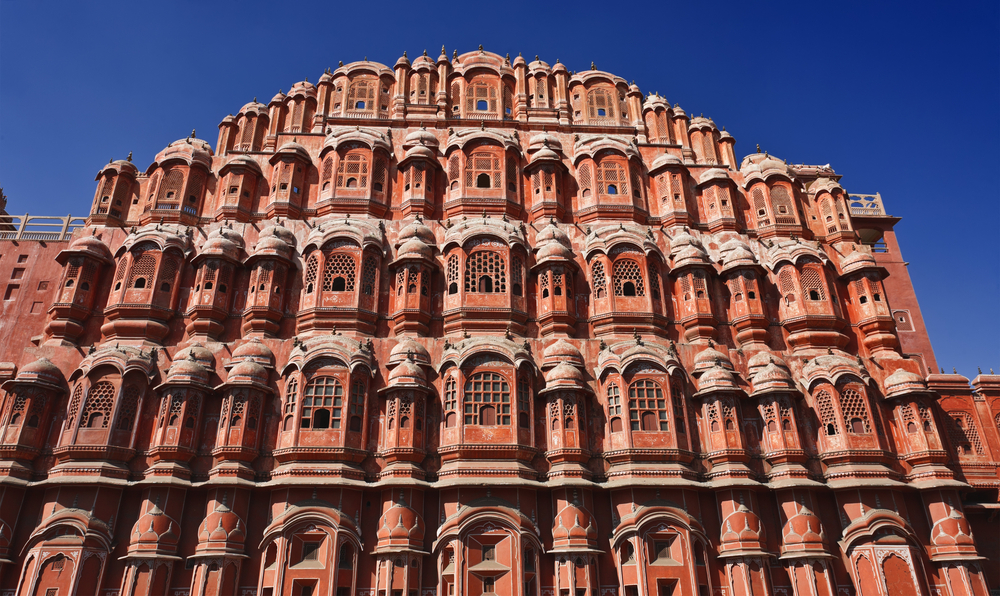
Golden Triangle
The Golden Triangle package is one of the best tours for someone travelling for the first time to India. This illustrious and admired Golden Triangle of Delhi, Agra and Jaipur, has its own mystic beauty and magical surprises that none of the areas can compare. This package is a poetic image of exotic India that focuses on the great mirth and the most notable parade of the Mughals and the Rajputs. The Golden Triangle tour sets in motion from the city full of life, Delhi and then it takes a twirl towards the city of romance and candor, Agra and finally steps into the city that arrays a pink carpet for all the visitors, Jaipur.
- Tour Duration: 5 Nights / 6 Days
- Places Covered: Delhi(2) > Agra(1) > Jaipur(2)
-
Day 1: Arrive Delhi
Your Golden Triangle trip begins with your arrival at the Delhi International Airport. At the airport, you will be received by a Trans India Holidays representative and he will escort you to the hotel and help you with the check-in formalities. The tour starts from the capital city- Delhi, the metropolis with an ideal combination of the ancient and the contemporary era. Delhi has two visible parts: a) New Delhi, the city created by the British, as the royal capital of India in 1911. b) The Old Delhi which was considered as the Muslim capital of India between the 17th and the 19th century. There are at least eight cities on the location of modern Delhi among which Indraprastha is one of the first recognized settlements, highlighted in the epic Mahabharata over 3000 years ago. Nevertheless, Delhi has always been one of the major cities in the northern region of the subcontinent. Overnight stay in Delhi
-
Day 2: In Delhi
After breakfast, the tour guide will pick you up from the hotel and take you for a guided sightseeing of Old and New Delhi. This tour includes the following places: Red Fort: The 17th-century fortress of the Mughals is inscribed as a UNESCO World Heritage Site. The term Red Fort is taken from a Hindi word Lal, which means red and Quila which means fort. The structure of the Red Fort is very uneven and it is placed in an octet shape along the Yamuna River. This fort is delimited by a wall of about 2.4 km in perimeter and is constructed of red sandstone. In 1638, Shah Jahan started building this huge fort and it was completed in 1648. The fort has a Diwan-e-Am (Hall for public audience), a Rang Mahal (a water-cooled apartment of royal ladies) and a Pearl Mosque, which was constructed with white marble. Red fort has two hallways: a) The Delhi gate and b) The Lahori gate, and both these gates face the renowned Chandni Chowk. Jama Masjid: Jama Masjid is one of the country’s major mosques where hundreds and thousands of Muslims offer their prayers even today. Jama Masjid was constructed by Shah Jahan as an architectural extravaganza in 1658. The wonders of construction in Jama Masjid are seen in the long stretches of stairs and the hefty courtyard. Chandni Chowk (Silver Street): Chandni Chowk is well-known for its flamboyant streets with the famous shopping spots of Old Delhi. It also has the country’s best known extensive market for textiles, electronic goods, and watches. Entire Chandni Chowk was designed by Jahanara Begum, Shah Jahan’s beloved daughter and was then populated by the well-to-do families of that time. The famous Paranthawale Gali, known for its mouthwatering paranthas is also positioned in Chandni Chowk. The famous gold market, Dariba Kalan is also situated here. Raj Ghat: An elementary square platform of black marble on the banks of Yamuna River, symbolizes the spot where Mahatma Gandhi was cremated after his assassination in 1948. A dedicatory ritual takes place each Friday, in his memory. India Gate: India Gate is free-standing, 42 metre high arch. It was built in 1931 and was formerly called the All India War Memorial in the memory of the 90,000 soldiers of the Indian Army who died in World War I. The names of the warriors are engraved all along the walls of the arch. The eternal flame was lit here to honor the Amar Jawan (Immortal Soldier), in 1971. Rashtrapati Bhavan (President’s House): Rashtrapati Bhavan is the authorized residence of the President of the country. It was designed by Lutyens and was the official residence of the Viceroy when the British ruled India. Humayun’s Tomb: Nine years after the death of Humayun, Haji Begum (widow of Humayun) built this tomb in 1565-66 in his memory. The garden tomb is one of the world heritage sites inscribed by UNESCO and is said to be the motivation behind the 'wonder of the world' Taj Mahal. Qutub Minar: This outstanding building in the Southern part of the capital was built by the Muslim King; Qutab–ud–din Aibak in 1199 A.D. The Minar (tower) is 72.5 meters tall and its base is a mosque. Overnight stay in Delhi.
-
Day 3: Drive Delhi - Agra (220 km/04 hrs)
You will be met by one of our representatives who will assist you with the check-out formalities. You will then start your trail to Agra, the next stop on your Golden Triangle tour package. The drive from Delhi to Agra will be via the new Expressway, one of India’s finest highways. Agra is situated on the bank of Yamuna River. It is the dwelling place to India’s famous monument, the Taj Mahal. Agra was the capital of Mughal Empire in the 16th & 17th centuries. On your arrival at the hotel in Agra, you will again be met by our representative and will be assisted with check-in formalities. Later in the afternoon, the tour guide will pick you up for the guided sightseeing trip of Taj Mahal and the Agra Fort. Taj Mahal: Emperor Shah Jahan constructed the Taj Mahal in the memory of his wife Mumtaj Mahal who died during the birth of their child in 1631. This white-marble mausoleum is one of the most beautiful structures in the world and is granted the title of one of the 'wonders of the world'. The UNESCO World Heritage Site is also known as the 'icon of eternal love'. Without a doubt, it is the most recognized and most visited landmark in India. The construction of this famous monument is said to have taken 22 years, starting from 1631. Over 20,000 artisans were working day and night for the construction of this landmark. Craftspersons and whizzes were brought from France and Italy. And the chief architect was from Iran. The visit to the Taj Mahal, will long be remembered by you as the highlight of your Golden Triangle Tour. Agra Fort: The centre of governance of the Mughal Empire, this historical monument is one of the world heritage sites in India. Emperor Akbar started the construction of this huge red sandstone Agra Fort on the bank of Yamuna River in 1565. It was mainly constructed for the soldiers until his grandson, Shah Jahan, added more opulent accommodations. There are a number of attractive buildings within its porches such as Samman Burj, where Shah Jahan was imprisoned by his son, Moti Masjid, a white marble mosque, Diwan–e–Am, Diwan–e–Khas, Jahangir’s Palace, Khaas Mahal and Shish Mahal. Overnight stay in Agra.
-
Day 4: Drive Agra - Jaipur (250 km/05 hrs)
After a relaxed breakfast at the hotel, you will be met by our representative and will be assisted with check-out formalities. You will then start your trip to Jaipur, the Pink city, the next stop on your Golden Triangle tour, en route stopping at Fatehpur Sikri, for a guided tour of this ancient capital. Fatehpur Sikri: Another world heritage site in Agra, Fatehpur Sikri is the deserted capital of Emperor Akbar roughly 35 kms outside Agra. This city was built in the 16th century and was abandoned for 12 years due to the paucity of water. The entire city is still intact, and a sight of this city is worth remembering. The Buland Darwaza is the main entrance to this city. It is 54 m tall. This gate was constructed in the honor of Akbar’s victory in Gujarat. After visiting Fatehpur Sikri, the drive takes a twirl to Jaipur, the third destination that forms India’s Golden Triangle. Jaipur It is the capital of Rajasthan, and is known as the “Pink City” because of the pink-tinted constructions in the old city. Recently the walled city of Jaipur has joined the elite list of UNESCO World Heritage Sites. It is situated on a dry lake bed, bordered by barren hills vanquished by forts and broken walls. The city was found in 1727 by Maharaja Jai Singh II, who wanted to be in the good books of the then ruling Mughals. He positioned the city with rectangular blocks according to early Hindu architecture. It is a great city for shopping. On arrival at the Jaipur hotel, you will again be received by our representative and will then be assisted with check-in formalities. Overnight stay in Jaipur.
-
Day 5: In Jaipur
After the morning meal, you will be picked up by the guide from the hotel and will be taken for a guided sightseeing tour of Jaipur and Amber. Sightseeing in Jaipur includes : Hawa Mahal (Palace of winds): Constructed by Maharaja Sawaj Pratap Singh in 1799, the Hawa Mahal is one of the Jaipur’s main landmarks, the front of the Mahal has pink windows and latticework screens. This mahal was initially constructed for the ladies of the imperial household to watch the ordinary life and parades of the city. City Palace: The City Palace is still the dwelling of the former royalty H.H Bhawani Singh Ji of Jaipur. This Palace still has an extensive collection of art, carpets and old weapons. Jantar Mantar (Observatory): It was built by Maharaja Jai Singh in 1728. Jantar Mantar appears to be an inquisitive collection of sculptures but in fact each construction has a detailed purpose such as measuring the positions of stars, altitudes and azimuths, and calculating eclipses. The most striking instrument is the sundial which is 27 meter tall gnomon. The shadow this casts moves up to 4 meters an hour. Amber Fort: The Amber Fort is located 11 km away from Jaipur. Amber was once the ancient capital of Jaipur. The Fort is an excellent illustration of Rajput architecture, impressively situated on a hillside facing a lake, which reflects its walkways and walls. Overnight stay in Jaipur.
-
Day 6: Drive Jaipur - Delhi (265 km/05 hrs) and depart Delhi
After a relaxing breakfast at the hotel, you will be met by our representative and will be assisted with the check out formalities. You will then start your drive to Delhi's International Airport in time for your flight back home.

Date & Price
Price
| Period | Standard | Superior | Deluxe | Premium |
|---|---|---|---|---|
| Valid from 16 Apr 2025 to 30 Sep 2025 | $ 790 Per Person | $ 834 Per Person | $ 895 Per Person | $ 1802 Per Person |
| Valid from 01 Oct 2025 to 15 Apr 2026 | $ 851 Per Person | $ 877 Per Person | $ 1000 Per Person | $ 2566 Per Person |
Accommodation
| Cities | Standard | Superior | Deluxe | Premium |
|---|---|---|---|---|
| Agra | Howard Plaza-The Fern | Jaypee Palace | ITC Mughal | The Oberoi Amarvilas |
| Delhi | Park Inn by Radisson | The Park | The Lalit | The Imperial |
| Jaipur | Alsisar Haveli | Lemon Tree Premier | ITC Rajputana | The Oberoi Rajvilas |
Important Information
- Small supplements may apply for travel between 25th October and 15th November, 20th December and 05th January and during the month of February.
- All the figures quoted above are net per person in US Dollars.
Inclusions
- Accommodation on twin sharing, bed & breakfast basis at the selected categories of hotels.
- Ground transportation as mentioned in the itinerary using an air-conditioned car.
- Sightseeing tours as per the itinerary along with an English speaking guide and including entrance fees to the monuments.



























